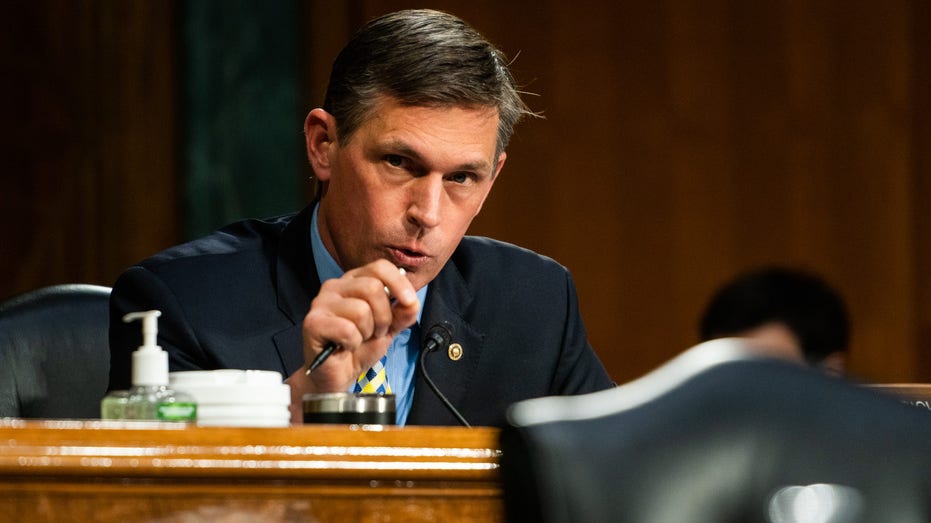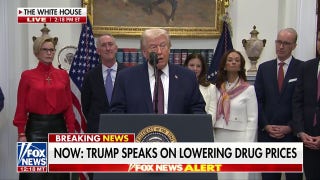Silicon Valley Bank collapse would have been 'prevented' if not for Trump deregulation, Senate Democrat says
New Mexico Senator Martin Heinrich blames bipartisan reforms to Dodd-Frank signed into law by President Donald Trump for SVB's collapse
Silicon Valley Bank a case of bad risk management: Carleton English
Barron's reporter Carleton English discusses who's to blame for the Silicon Valley Bank failure on 'Varney & Co.'
The top Democrat on the Joint Economic Committee (JEC) in Congress is blaming regulatory rollback under former President Trump for Silicon Valley Bank's failure and is calling for new "proactive regulation."
Sen. Martin Heinrich, D-N.M., the JEC's chairman-designate, released a statement Monday praising actions taken by the Biden administration to stabilize the banking system and tech industry after Silicon Valley Bank (SVB) went insolvent and was taken over by the Federal Deposit Insurance Corporation (FDIC).
"While I am glad that the administration and regulators acted quickly to ensure small businesses and depositors didn’t take the brunt of this failure, this disaster may have been prevented," Heinrich said.
In his statement, Heinrich criticized bipartisan reforms to elements of Dodd-Frank in 2018, saying that deregulation set the stage for SVB's failure.
LIBERALS BLAME TRUMP FOR SILICON VALLEY BANK COLLAPSE CITING 2018 BIPARTISAN BILL

Senator Martin Heinrich, D-N.M., is calling for increased regulation of banks following Silicon Valley Bank's collapse. (Demetrius Freeman-Pool/Getty Images / Getty Images)
"The reforms in the Dodd-Frank Act were put in place to ensure the stability of the U.S. financial system, in part by letting regulators take a clear look at the health and soundness of individual banks. Unfortunately, President Trump’s regulatory rollback has led us here," Heinrich said.
The New Mexico senator noted that the Joint Economic Committee had named SVB Financial Group in 2018 as one of the banks that would face almost none of the regulations originally implemented by Dodd-Frank under the changes to the law.
SVB went insolvent last week after depositors panicked over the bank's health and rushed to withdraw their funds. It was the second-largest bank failure in U.S. history. As of last year, the bank held $209 billion in assets and $175.4 billion in deposits, according to the FDIC.
| Ticker | Security | Last | Change | Change % |
|---|---|---|---|---|
| SIVB | NO DATA AVAILABLE | - | - | - |
On Wednesday, the bank posted $1.8 billion losses as its stock price fell 60%. By Friday, the FDIC had assumed control of its operations and had begun making plans to return the insured deposits of customers that wanted them.
Over the weekend, the Treasury Department, FDIC, and Federal Reserve, citing "systemic risk" posed by SVB's failure, announced that FDIC insurance funds will be used to prevent depositors from losing money, even if their deposits were in excess of the $250,000 statutory limit for deposit insurance. Critics called the move a bailout, but the Biden administration denied that characterization, pointing out "no losses associated with the resolution of Silicon Valley Bank will be borne by the taxpayer."
SILICON VALLEY BANK: FED SAYS VICE CHAIR FOR SUPERVISION TO REVIEW WHAT LED TO COLLAPSE

A customer stands outside of a shuttered Silicon Valley Bank (SVB) headquarters on March 10, 2023, in Santa Clara, California. Silicon Valley Bank was shut down on Friday morning by California regulators and was put in control of the U.S. Federal Dep (Justin Sullivan/Getty Images / Getty Images)
Heinrich spoke favorably of these "key steps" taken to ensure that businesses who deposited with SVB keep their money and continue to make payroll.
"Instead of bailing out shareholders or using taxpayer money, the Federal Reserve and other agencies will collect money from other regulated banks in order to protect the customers who banked with SVB, which include many small businesses," Heinrich said.
"While I agree with this solution and have confidence in regulators’ ability to prevent any further bank runs, these measures are no substitute for proactive regulation and formal deposit insurance requirements that respond to the needs of today's economy."
Conservative economists dispute the need for increased regulation in response to SVB's failure.
EJ Antoni, research fellow in regional economics with The Heritage Foundation’s Center for Data Analysis, told FOX Business on Saturday that the collapse had "nothing to do with Trump or Dodd-Frank" and more to do with an "unusual confluence of events."
SILICON VALLEY BANK COLLAPSE UNDER INVESTIGATION BY JUSTICE DEPARTMENT

Pasadena Police Officers drive past the open Silicon Valley Bank Private branch in Pasadena, California, on Monday, March 13, 2023. (AP Photo/Damian Dovarganes / AP Images)
Antoni explained that the bank "dealt almost exclusively with tech firms which usually rely on continuously rolling over large debts" which means that the firms are "not paying off their debt but simply taking out new debt to pay off the old."
"Second, SVB put a disproportionate amount of its cash into long-term bonds. Ordinarily, that’s not a bad strategy, but it’s unwise when interest rates are zero because those rates must rise eventually," Antoni said. "When rates rise, bond prices fall. This is because an investor with the choice to buy an existing bond at a low rate or a new bond at a high rate will choose the new bond since it’s a better return on investment. If you want to sell the old bond with its lower interest rate, you must be willing to sell it at a discount; otherwise, no one will buy it."
GET FOX BUSINESS ON THE GO BY CLICKING HERE
In Antoni's telling, SVB set itself up for failure by tying up most of its deposits in bonds and having an undiversified clientele that all needed their money at the same time.
"SVB had to sell its bonds at a loss to raise cash," Antoni said. "Limited transactions like this would not have been catastrophic, and in fact happen regularly in the financial sector on a small scale."
"SVB was a case of mismanagement that was made possible by the unrealistically low rates from the Federal Reserve," Antoni told FOX Business.
FOX Business' Andrew Miller contributed to this report.





















